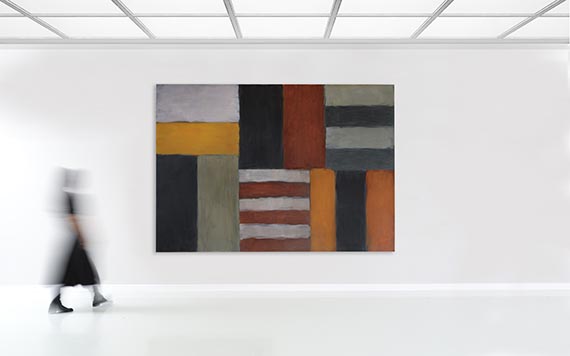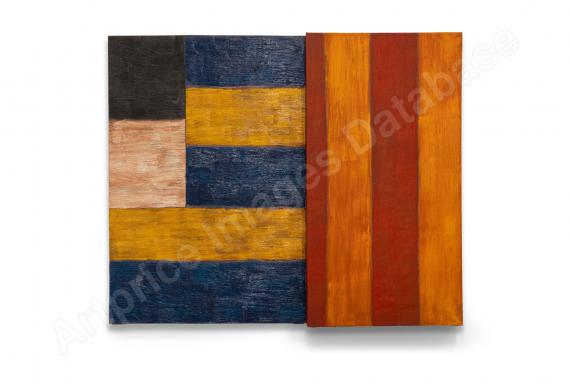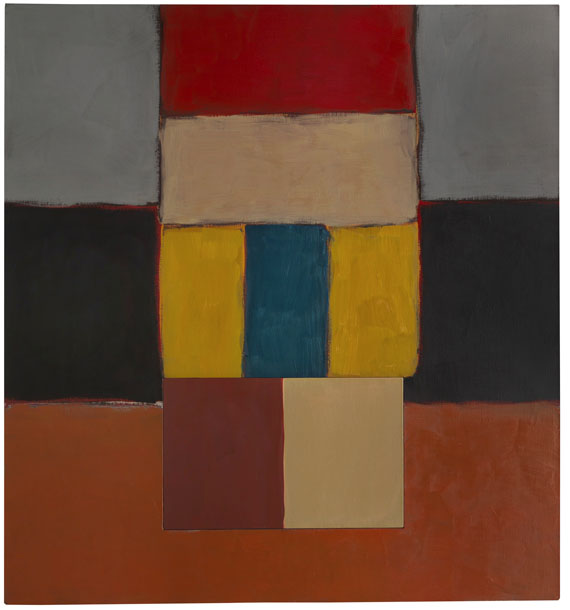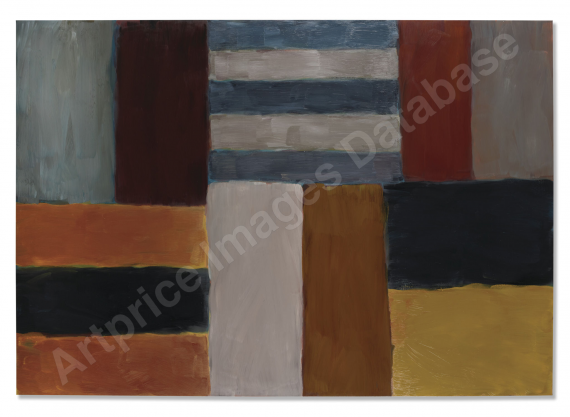Vente: 550 / Evening Sale 07 juin 2024 à Munich  Lot 124000264
Lot 124000264
 Lot 124000264
Lot 124000264
Autre image
Autre image
Autre image
Autre image
Autre image
124000264
Sean Scully
Cut Ground Orange, 2009.
Oil on canvas
Estimation: € 800,000 / $ 856,000
Les informations sur la commission d´achat, les taxes et le droit de suite sont disponibles quatre semaines avant la vente.
Cut Ground Orange. 2009.
Oil on canvas.
Signed, dated and titled on the reverse. 213 x 305 x 6 cm (83.8 x 120 x 2.3 in). [CH].
• Monumental work from the "Cut Ground" series that commenced in 2006.
• The great variety of color stripes in an architectural arrangement and their matt-glossy quality create a fascinating composition with a sculptural effect.
• Scully evokes an interplay of asymmetry and uniformity, harmony and disharmony, strict geometry and sensual imperfection.
• “Cut Ground Orange” embraces the viewer with its warm colors and emotional expressiveness, its sheer size and spatial presence.
• Works from this series are in the collection of the Metropolitan Museum of Art in New York, in the Virginia Museum of Fine Arts, Richmond, and in the Fundación Bancaja in Valencia.
PROVENANCE: Walter Storms Galerie, Munich.
Private collection Rhineland (acquired from the above in 2009).
Oil on canvas.
Signed, dated and titled on the reverse. 213 x 305 x 6 cm (83.8 x 120 x 2.3 in). [CH].
• Monumental work from the "Cut Ground" series that commenced in 2006.
• The great variety of color stripes in an architectural arrangement and their matt-glossy quality create a fascinating composition with a sculptural effect.
• Scully evokes an interplay of asymmetry and uniformity, harmony and disharmony, strict geometry and sensual imperfection.
• “Cut Ground Orange” embraces the viewer with its warm colors and emotional expressiveness, its sheer size and spatial presence.
• Works from this series are in the collection of the Metropolitan Museum of Art in New York, in the Virginia Museum of Fine Arts, Richmond, and in the Fundación Bancaja in Valencia.
PROVENANCE: Walter Storms Galerie, Munich.
Private collection Rhineland (acquired from the above in 2009).
“My paintings want to tell stories”
The strictly geometric abstraction and sensual opulence of “Cut Ground Orange” extends over a length of three meters and covers an area of more than six square meters. Ever since the beginnings of his artistic career in the 1970s, the Irish-born artist Sean Scully, who emigrated to the USA in 1975, has fully committed himself to abstraction. His works testify to his fascination with geometrically structured surfaces, creating compositions that show a variety of vertical and horizontal stripes. Early pieces from the 1970s are made up of very precise, strictly geometric and minimalist stripe patterns that would become wider over the course of the 1980s, with freer transitions, while a more sensual painterly style can also be felt. From the 1990s onward, Scully finally refined the stripes into stacked color blocks of almost equal size, which he arranged in highly harmonious compositions. The present work from the "Cut Ground" series, which he began in 2006, is a more daring variation: In contrast to the mostly uniform compositional pattern of other work series, the "Cut Ground" works also feature narrower stripes that add dynamism to the composition and determine their energy flow. To Scully it is all about the relationship between colors and shapes, he explains: "My paintings are about relationships. How bodies come together. How they touch and how they part. How they live together, in harmony and disharmony. The bodies in my work are subject to a constant change that depends on the color [.]. The edges define the relationship to their neighbors and how they exist in context. My paintings want to tell stories that can be understood as abstract equivalents of how relationships in our world emerge and fade.” (Sean Scully in a discussion with W. Smerling, in: ex. cat. Konstantinopel oder das sinnlich Verborgene. Die Bilderwelt von Sean Scully, MKM Museum Küppersmühle für Moderne Kunst, Duisburg 2009, p. 8).
Harmony and disharmony
Hence the basic principle of these works is the order and arrangement of the color fields. Scully's work starts with the organization of the canvas, it is divided into rectangular elements and stripes in oil pastel. For “Cut Ground Orange”, Scully chose a layout of 2 x 3 panels of almost equal size, which he in turn divided into stripes of different widths: narrow stripes (bottom center), slightly wider color bars (top right) and bold, much flatter blocks (top center). These areas are painted in overlapping layers of paint with a broad brush in gestural, free, even rhythmic strokes. A process that runs counter to the apparent rigidity and simplicity of the well thought-out arrangement: colors overlap, blur and repeatedly allow the viewer to witness the artist's manual work and thus the process of creation: “Of course you can feel time in my work because it consists of layers. Repeatedly painted over, in different colors and with different pigment densities, always by my hand, until somehow everything [..] is in its right place where it can live." (Sean Scully in a discussion with Kevin Power, quoted from: Kelly Grovier/Kirsten Voigt (eds.), Inner, Berlin 2018, p. 104).
A seemingly rational, almost architectural composition of geometric shapes and horizontal and vertical lines, quickly reveals its qualities as a masterpiece of a perfectly balanced spectacle of harmony and fascinating discord: The borders of the color fields are not razor-sharp, they have a painterly flow; their edges do not meet exactly, they are not accurately composed but stand on their own and have an asymmetrical relationship with the adjacent surfaces: each color block is designed both as an independent unit as well as a part of the whole composition.
Contrast comes from the cool and warm color areas that are so close to one another: Warm orange meets light gray, strong yellow meets deep black. Darker color panels help their lighter, strong yellow neighbors to achieve a surprising radiance, creating a stimulating "patchwork".
Moroccan fabrics and Abstract Expressionism
Scully describes a trip to Morocco in 1969 as a key moment: “Then I saw the striped fabrics that the Moroccans dye and make them into galabeyas - their robes. I saw those stripes everywhere in Morocco and when I got back to work I was making grids from stripes of color.” (Sean Scully, quoted from: www.seanscullystudio.com) The typical garments of the Maghreb and the rich colors found everywhere, which are also evident in "Cut Ground Orange", sparked a great fascination in Scully that helped him attain an indepent style at the very beginning of his career. While early works still show a certain minimalism and a stricter structure, Scully would find his way to a more emotional form of abstract painting in which light, materiality and haptics started to play a major role. The stylistic devices became softer, spaces between the bars and stripes more imperfect. He attributed this development to the influence of Abstract Expressionism, in particular to the vibrant color fields of Mark Rothko or Barnett Newman, which the artist studied intensively, especially after his relocation to New York in 1975. Like Rothko, Scully is also obsessed with the effect of colors and their relationships to one another, creating and conveying emotions and moods. “I am convinced that abstraction is and was there to embody deep emotion. I believe that is its role in art history." (S. Scully, 2012, quoted from: Kelly Grovier/Kirsten Voigt (eds.), Inner, Berlin 2018, p. 280).
Scully applies an architectural structure, so to speak, to Rothko's atmospheric use of color, lending structure and weight to Rothko's sensual clouds of color. (Cf. S. B. Phillips, “Becoming Sean Scully”, in: ex. cat. Wall of Light, Phillips Collection, Washington, D.C. 2005, p. 19).
Sensuality and plasticity
The expressive power of Scully's works, including “Cut Ground Orange”, emerges in the painting process, it comes about 'geologically', so to speak, like rock layers, slowly building up from the bottom layer of paint to the surface. The layering that can still be seen in the transitions between the color fields, the special materiality of the subtly shiny surface and the broad brush strokes that remain visible lend the painting vibrancy and sensual opulence. In combination with the work's monumentality, he achieves an expansive sculptural presence.
The impression of plasticity is also enhanced by the descriptive title of our painting, which is reminiscent of the laborious peat cutting that has been practiced in Scully's native Ireland for centuries. Scully's paintings reflect visual impressions from the past and present. Inspirations from nature, everyday life and personal experiences are expressed in a particular form and in different colors. The broad blocks of color in “Cut Ground Orange” - the warm, almost fiery orange, stone gray, sooty black and mustard yellow - evoke elements and aspects of nature, while the forms refer to, among others, the old walls of horizontally and vertically layered stones on the Irish Aran Islands, which the artist immortalized in his photographic series “Aran” from 2005 and which also inspired his sculptural works such as “Wall Dale Cubed” (2018, Yorkshire Sculpture Park).
“Cut Ground Orange” fascinates and confronts us with finely nuanced yet powerful colors and sheer monumentality.
Scully creates an assemblage of formal austerity and sensual opulence, of architectural composition and asymmetry, of gestural brushwork and repeated layering, of associative richness and intuitive colorfulness, of light and shadow, of coarse blocks of color and painterly stripes of color. The work offered here from the “Cut Ground” series thus embodies the essence of Scully's art. The iconic body of juxtaposed and stacked, cold and warm-toned, lighter and darker color fields crystallize the best of Scully's art, his dedication and unrelenting commitment to abstract painting.
At the pinnacle of his career
Scully's oeuvre spans paintings, pastels, watercolors and drawings, prints, photographs and sculptures and is part of the world's most prestigious collections like the Museum of Modern Art, the Metropolitan Museum of Art and the Solomon R. Guggenheim Museum in New York, the National Gallery of Art in Washington, D.C. and the Tate Gallery in London. Thanks to a success story that has lasted more than five decades, he is now one of the most important artists of his generation. In 2013, the artist became a member of the Royal Academy of Arts, and in 2014/15 he was the first Western artist ever to be honored with a comprehensive, retrospective exhibition in Shanghai and Beijing. In the last five years alone, his work has been shown in more than a dozen solo exhibitions in Europe and the United States, including a show at the Thorvaldsen Museum in Copenhagen (2023), the large-scale exhibition “Sean Scully. The Shape of Ideas” at the Philadelphia Museum of Art (2022), at the National Gallery in London and the Albertina in Vienna (2019) and at the Hirshhorn Museum and Sculpture Garden in Washington, D.C. (2018/19). [CH]
The strictly geometric abstraction and sensual opulence of “Cut Ground Orange” extends over a length of three meters and covers an area of more than six square meters. Ever since the beginnings of his artistic career in the 1970s, the Irish-born artist Sean Scully, who emigrated to the USA in 1975, has fully committed himself to abstraction. His works testify to his fascination with geometrically structured surfaces, creating compositions that show a variety of vertical and horizontal stripes. Early pieces from the 1970s are made up of very precise, strictly geometric and minimalist stripe patterns that would become wider over the course of the 1980s, with freer transitions, while a more sensual painterly style can also be felt. From the 1990s onward, Scully finally refined the stripes into stacked color blocks of almost equal size, which he arranged in highly harmonious compositions. The present work from the "Cut Ground" series, which he began in 2006, is a more daring variation: In contrast to the mostly uniform compositional pattern of other work series, the "Cut Ground" works also feature narrower stripes that add dynamism to the composition and determine their energy flow. To Scully it is all about the relationship between colors and shapes, he explains: "My paintings are about relationships. How bodies come together. How they touch and how they part. How they live together, in harmony and disharmony. The bodies in my work are subject to a constant change that depends on the color [.]. The edges define the relationship to their neighbors and how they exist in context. My paintings want to tell stories that can be understood as abstract equivalents of how relationships in our world emerge and fade.” (Sean Scully in a discussion with W. Smerling, in: ex. cat. Konstantinopel oder das sinnlich Verborgene. Die Bilderwelt von Sean Scully, MKM Museum Küppersmühle für Moderne Kunst, Duisburg 2009, p. 8).
Harmony and disharmony
Hence the basic principle of these works is the order and arrangement of the color fields. Scully's work starts with the organization of the canvas, it is divided into rectangular elements and stripes in oil pastel. For “Cut Ground Orange”, Scully chose a layout of 2 x 3 panels of almost equal size, which he in turn divided into stripes of different widths: narrow stripes (bottom center), slightly wider color bars (top right) and bold, much flatter blocks (top center). These areas are painted in overlapping layers of paint with a broad brush in gestural, free, even rhythmic strokes. A process that runs counter to the apparent rigidity and simplicity of the well thought-out arrangement: colors overlap, blur and repeatedly allow the viewer to witness the artist's manual work and thus the process of creation: “Of course you can feel time in my work because it consists of layers. Repeatedly painted over, in different colors and with different pigment densities, always by my hand, until somehow everything [..] is in its right place where it can live." (Sean Scully in a discussion with Kevin Power, quoted from: Kelly Grovier/Kirsten Voigt (eds.), Inner, Berlin 2018, p. 104).
A seemingly rational, almost architectural composition of geometric shapes and horizontal and vertical lines, quickly reveals its qualities as a masterpiece of a perfectly balanced spectacle of harmony and fascinating discord: The borders of the color fields are not razor-sharp, they have a painterly flow; their edges do not meet exactly, they are not accurately composed but stand on their own and have an asymmetrical relationship with the adjacent surfaces: each color block is designed both as an independent unit as well as a part of the whole composition.
Contrast comes from the cool and warm color areas that are so close to one another: Warm orange meets light gray, strong yellow meets deep black. Darker color panels help their lighter, strong yellow neighbors to achieve a surprising radiance, creating a stimulating "patchwork".
Moroccan fabrics and Abstract Expressionism
Scully describes a trip to Morocco in 1969 as a key moment: “Then I saw the striped fabrics that the Moroccans dye and make them into galabeyas - their robes. I saw those stripes everywhere in Morocco and when I got back to work I was making grids from stripes of color.” (Sean Scully, quoted from: www.seanscullystudio.com) The typical garments of the Maghreb and the rich colors found everywhere, which are also evident in "Cut Ground Orange", sparked a great fascination in Scully that helped him attain an indepent style at the very beginning of his career. While early works still show a certain minimalism and a stricter structure, Scully would find his way to a more emotional form of abstract painting in which light, materiality and haptics started to play a major role. The stylistic devices became softer, spaces between the bars and stripes more imperfect. He attributed this development to the influence of Abstract Expressionism, in particular to the vibrant color fields of Mark Rothko or Barnett Newman, which the artist studied intensively, especially after his relocation to New York in 1975. Like Rothko, Scully is also obsessed with the effect of colors and their relationships to one another, creating and conveying emotions and moods. “I am convinced that abstraction is and was there to embody deep emotion. I believe that is its role in art history." (S. Scully, 2012, quoted from: Kelly Grovier/Kirsten Voigt (eds.), Inner, Berlin 2018, p. 280).
Scully applies an architectural structure, so to speak, to Rothko's atmospheric use of color, lending structure and weight to Rothko's sensual clouds of color. (Cf. S. B. Phillips, “Becoming Sean Scully”, in: ex. cat. Wall of Light, Phillips Collection, Washington, D.C. 2005, p. 19).
Sensuality and plasticity
The expressive power of Scully's works, including “Cut Ground Orange”, emerges in the painting process, it comes about 'geologically', so to speak, like rock layers, slowly building up from the bottom layer of paint to the surface. The layering that can still be seen in the transitions between the color fields, the special materiality of the subtly shiny surface and the broad brush strokes that remain visible lend the painting vibrancy and sensual opulence. In combination with the work's monumentality, he achieves an expansive sculptural presence.
The impression of plasticity is also enhanced by the descriptive title of our painting, which is reminiscent of the laborious peat cutting that has been practiced in Scully's native Ireland for centuries. Scully's paintings reflect visual impressions from the past and present. Inspirations from nature, everyday life and personal experiences are expressed in a particular form and in different colors. The broad blocks of color in “Cut Ground Orange” - the warm, almost fiery orange, stone gray, sooty black and mustard yellow - evoke elements and aspects of nature, while the forms refer to, among others, the old walls of horizontally and vertically layered stones on the Irish Aran Islands, which the artist immortalized in his photographic series “Aran” from 2005 and which also inspired his sculptural works such as “Wall Dale Cubed” (2018, Yorkshire Sculpture Park).
“Cut Ground Orange” fascinates and confronts us with finely nuanced yet powerful colors and sheer monumentality.
Scully creates an assemblage of formal austerity and sensual opulence, of architectural composition and asymmetry, of gestural brushwork and repeated layering, of associative richness and intuitive colorfulness, of light and shadow, of coarse blocks of color and painterly stripes of color. The work offered here from the “Cut Ground” series thus embodies the essence of Scully's art. The iconic body of juxtaposed and stacked, cold and warm-toned, lighter and darker color fields crystallize the best of Scully's art, his dedication and unrelenting commitment to abstract painting.
At the pinnacle of his career
Scully's oeuvre spans paintings, pastels, watercolors and drawings, prints, photographs and sculptures and is part of the world's most prestigious collections like the Museum of Modern Art, the Metropolitan Museum of Art and the Solomon R. Guggenheim Museum in New York, the National Gallery of Art in Washington, D.C. and the Tate Gallery in London. Thanks to a success story that has lasted more than five decades, he is now one of the most important artists of his generation. In 2013, the artist became a member of the Royal Academy of Arts, and in 2014/15 he was the first Western artist ever to be honored with a comprehensive, retrospective exhibition in Shanghai and Beijing. In the last five years alone, his work has been shown in more than a dozen solo exhibitions in Europe and the United States, including a show at the Thorvaldsen Museum in Copenhagen (2023), the large-scale exhibition “Sean Scully. The Shape of Ideas” at the Philadelphia Museum of Art (2022), at the National Gallery in London and the Albertina in Vienna (2019) and at the Hirshhorn Museum and Sculpture Garden in Washington, D.C. (2018/19). [CH]
124000264
Sean Scully
Cut Ground Orange, 2009.
Oil on canvas
Estimation: € 800,000 / $ 856,000
Les informations sur la commission d´achat, les taxes et le droit de suite sont disponibles quatre semaines avant la vente.







